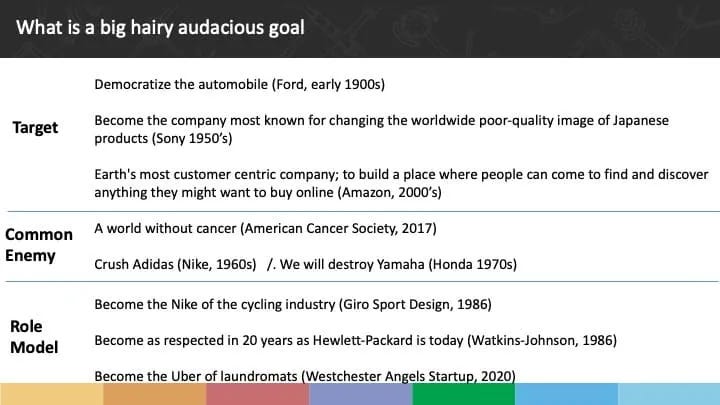North Star Vision Template & Why You Care Enough to Fill It Out
What is a North Star Vision and how you can create one to energize your team and accomplish great things.
The Star is a symbol of direction and a tool for navigation. It has been for centuries. It is independent of where the navigator is in their journey but always represents an ambitious direction.
The North Star vision is a long-term vision that is always there, provides direction, inspires, is clear and visible, and is attained with incredible difficulty. It is not dependent on where you are today; it only exists in the future as a guide.
What everyone gets wrong when starting a business is they show up to work every day, solve problems, and do work, but these will not automatically build to something bigger.
Worse, doing aimless work leads to more work; even hiring people creates work unless you purposefully create something different.
Instead, create something on purpose by envisioning what you will create.
If you cannot express to the people you hire what it is you and they are working toward, they may do lots of earnest work, but it will never amount to anything more than the sum of their work. Thanks to the law of diminishing returns, you will find that as you hire people, each additional person you hire will contribute less.
Without a North Star Vision, your team’s total work will be less than the sum of their individual contributions.
Okay, I realize that is a little hard to digest, but hopefully, it will be clearer by the end of this post.
The cure is creating a North Star Vision, so everyone knows what you are building. So, read more to understand why you need a vision, how it impacts your business, and how to make one.
Start here: without a vision, nobody knows where you are going; with a vision, everyone can take action.
In the book “Made to Stick,” the authors (Chip Heath and Dan Heath) recount a story in which Herb Kelleher told someone that once you understand that, you can make decisions about the company’s future as well as he can.
His example was “someone named Tracey from the marketing department” who “comes to your office and tells you that, based on a survey, passengers might enjoy a salad from Houston to Las Vegas. But we serve only peanuts and would it be nice to serve chicken Ceasar salad. How would you respond?”
I have been in many board rooms where just such a question would tie the executive team up in knots.
I’ve seen analytic committees and consultants hired to answer questions like this. McKinsey & Co. created a whole business of making chicken Caesar salad recommendations and being the scapegoat if those recommendations went wrong.
Without the clarity of vision, employees who would otherwise be productive spend time on chicken salad analysis. Everybody is busy doing lots of work, but they are not doing the right job; they are not building together to create something larger than themselves because they lack the clarity of vision.
Once you understand that South West’s vision is to be a low-cost airline, you only have to ask one question: Will serving a chicken Caesar salad help make South West lower-cost?
Of course not. So, in Herb’s words: “If it doesn’t, then we are not serving any damn chicken salad.”
Great companies are built on grand visions because they focus people today on achieving that vision tomorrow.
In the 1950s, Sony envisioned a world where Japanese products would be seen as quality products and where Japan would be seen as a technological leader.
They did this after a devastating war that killed millions and destroyed cities and used their vision to inspire the Japanese to build stronger and take a technological lead.
In the 1900s, Ford envisioned a world where all workers could afford an automobile; he inspired his employees to work hard at monotonous jobs: they were doing something more than taping a screw. They were democratizing the car.
In the 1970s, Honda envisioned destroying Yamaha; their employees knew whom they were after and what they were up to and felt riled up to make it happen.
Start with an inspiring, almost unattainable goal that is far off in the future.
Your vision should be 10-20 years in the future. We generally settle on 15, but the actual number of years doesn’t matter. It should be long enough for almost anything to be possible.
Then, create an inspiring goal for your company that is only attainable with focus, dedication, hard work, and perhaps a bit of luck for that time frame. In other words, set a Big Hairy Audacious Goal, or BHAG, for that future.
In their article “Building Your Company’s Vision,” James C. Collins and Jerry I. Porras suggest that a BHAG only has a 50/50 or worse probability of success. Nobody can do it alone, but everyone in the organization believes they can reach that goal together.
Collins and Porras identified four types of big, hairy, audacious goals. These are:
Targets, which are either quantitative or qualitative. You identify where your company will be in 15 years, a market leader or $100 million.
A common enemy goal generally involves David versus Goliath-type thinking, such as displacing the number one company in your industry or, as Honda put it in the 1970s, “destroying Yamaha.”
Role model goals work well for up-and-coming companies. For example, “We will become the Uber of dry cleaning.”
Internal transformation goals focus on changing the organization. They are best for established companies or teams looking to change.
Here are some examples of North Star Visions from successful companies.
Once you have your BHAG, create a vivid description
By definition, your objective doesn’t exist. It is your goal; it is what you intend to achieve. So, it doesn’t exist today.
Paint a picture and show your stakeholders what the world looks like when you are finished.
This is the power that Ford brought to his vision of an automobile. The company wasn’t just building cars; they were building “motorcars for the great multitude… priced so low that no man making a good salary will be unable to own one.”
And that George Merck brought to Merck when he expressed his vision with words like: “We believe that research work carried on with patience and persistence will bring to industry and commerce new life; and we have faith that in this new laboratory, with the tool we have supplied, science will be advanced, knowledge increased, and human life win ever greater freedom from suffering and disease.
Or when Sony declared that, because of their work, “Made in Japan” would mean something well made, not something shoddy.
These companies achieved these visions not by completing them and then describing what they achieved but by defining what they would achieve and striving for it.
We have to go back 30-100 years to find big visions and show their success because that is the time it takes to realize a BHAG.
Your vision may not include taking over the world or redefining how the world perceives your nation. You may not want to be involved with your company in 15 years. But for the company to thrive and for you to thrive as an MSP owner, you must define where the company is going and create a vivid description that inspires everyone working to get there.
Step-by-step instructions to create your vision
Decide whether you want to start with the BHAG or the vivid description.
Design your vivid description.
Often, it is easier to start with a vivid description; here are some questions to get you started:
When sitting here 15 years from now, what would we have liked to create?
What should this company look like in 15 years?
What should the company have achieved?
If someone writes an article about this company in 15 years, what should it say?
What is a 5-star review? What is a 10-star review?
Then, also consider how you want to define your BHAG. Think in terms of:
What targets will you achieve?
What common enemy can you overcome?
What company might you emulate?
What transformation do you want to see in your company?
Finally, test the vision. For it to be useful, inspiring, and serve as a guide, it must satisfy these criteria:
You personally identify with the vision. (Ask this of all of your leaders).
The future is clear (words, metaphors, analogies, and/or pictures).
It expresses your interests.
You feel encouraged.
It is clear how you make a difference for your stakeholders.
It is a stretch, from where you are today, perhaps impossible.
It is authentic.
The journey is worthwhile.
It is intellectually and emotionally energizing.
To sum up
Your vision is yours. It is a crucial part of the path and one that brings people together. At the beginning of this post, I mention the law of diminishing returns. The challenge is that as you add people, you add management complexity, leading to reduced output.
Vision reduces management complexity. It isn’t the only tool, but it is an important one. Once people know where they are going, they can dedicate effort to getting there. You move from diminishing returns to synergy, where you get more productivity than the sum of the individual contributions. Just tell people where they are going.
What's Next:
Once you've got your vision, it is worth considering your mission.
Get started creating the mission for your business here.






![How to create your north star vision and why it matters for your business [template] 4 Targets and SMART Goals](https://substackcdn.com/image/fetch/w_1456,c_limit,f_auto,q_auto:good,fl_progressive:steep/https%3A%2F%2Fsubstack-post-media.s3.amazonaws.com%2Fpublic%2Fimages%2F0676fae8-4d99-4cf8-a3b4-ffd4e108c33e_768x568.webp)

![How to create your north star vision and why it matters for your business [template] 6](https://substackcdn.com/image/fetch/w_1456,c_limit,f_auto,q_auto:good,fl_progressive:steep/https%3A%2F%2Fsubstack-post-media.s3.amazonaws.com%2Fpublic%2Fimages%2Fdd094efa-b385-4154-a6df-6d39fae5e3fe_720x405.webp)